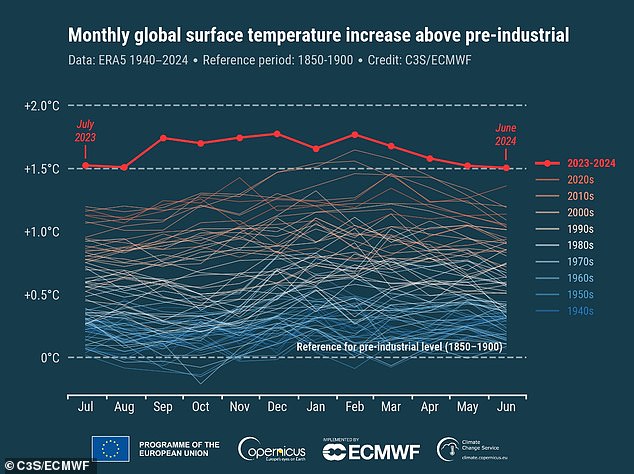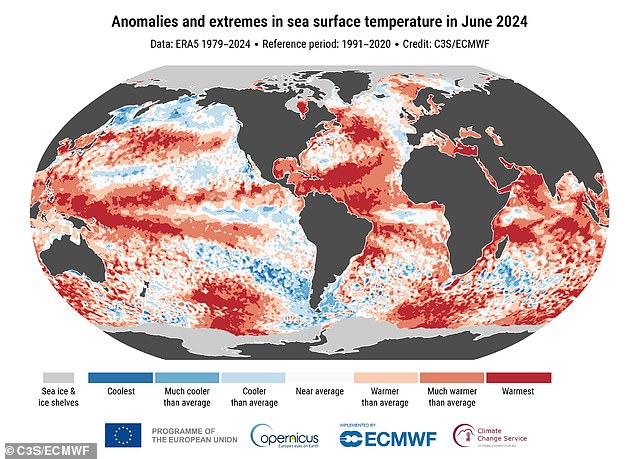In Britain, June was a “month of contrasts”, with showers and the occasional late burst of heat.
But globally, Earth experienced its hottest June on record, according to scientists from the EU climate change programme.
Last month was not only the hottest month of the year so far, but also the 13th consecutive record-breaking month.
In other words, every month since June 2023 has been the warmest on record for that particular month, indicating an ongoing warming trend.
Experts point to greenhouse gas emissions as the cause and warn of an unfolding “climate disaster.”
June 2024 was the warmest June on record globally, with an average surface air temperature of 16.66 °C (61.98 °F). This map shows where Earth experienced extremes in terms of heat last month, compared to the 1991-2020 reference period.

Globally, June 2024 was the hottest June since at least 1940, when EU department records began. Pictured, people cool off at Coney Island on a sweltering afternoon on the first day of summer, June 20, 2024, in New York City.
According to the The EU Copernicus programme Climate change Service (C3S), the The global average temperature for June 2024 was 61.98 °F (16.66 °C).
This is 0.25 °F (0.14 °C) warmer than the temperature of the previous warmest June: June 2023.
Worryingly, this temperature is also 1.2°F (0.67°C) warmer than the global average for June over the 1991–2020 period.
“June marks the 13th consecutive month of record-breaking global temperatures and the 12th consecutive month with temperatures above 1.5°C relative to pre-industrial conditions,” said Carlo Buontempo, director of C3S.
‘This is more than a statistical oddity and highlights a large and ongoing change in our climate.
‘Even if this particular streak of extremes ends at some point, we will surely see new records as the climate continues to warm.
“This is inevitable unless we stop emitting greenhouse gases into the atmosphere and oceans.”

According to C3S, June 2024 was 2.7°F (1.5°C) above the estimated June average for 1850–1900, the designated preindustrial reference period.

People protect themselves from the sun with an umbrella as they stand at Sultanahmet Square, one of the city’s best-known tourist attractions, in Istanbul, Turkey, June 28, 2024.

June marks the 13th consecutive month of record-breaking temperatures globally. Pictured, a woman cools off in a fountain in Moscow, Russia, June 30, 2024.
C3S, managed by the European Commission, analyses temperature readings based on a variety of platforms and instruments, from weather stations to weather balloons and satellites.
The department’s readings refer to the average air temperature for the entire planet over the entire year, meaning they are lower than a single, typically “warm” temperature reading.
According to C3S, the June 2024 temperature was 2.7°F (1.5°C) above the estimated June average for 1850–1900, the designated preindustrial reference period.
What’s more, the global average temperature over the past 12 months (July 2023 to June 2024) is now the highest on record.
The past 12 months have been 1.36°F (0.76°C) above the 1991-2020 average and 2.95°F (1.64°C) above the preindustrial average from 1850 to 1900, the department said.

A man cools off as he stands in front of ‘water spray fans’ placed on the side of the road as temperatures soar in the capital Baghdad on June 30, 2024

Long periods of hot, dry weather and lack of rain increase the likelihood of wildfires. Pictured, a firefighting helicopter drops water as a wildfire burns in Stamata, near Athens, Greece, June 30, 2024.
Looking at Europe separately from the rest of the world, temperatures last month were 2.82°F (1.57°C) above the average for June between 1991 and 2020, making it the second-warmest June for Europe.
European temperatures were above average in southeastern regions and Turkey, but close to or below average in Western Europe, Iceland and northwestern Russia.
Outside Europe, temperatures were higher than average in eastern Canada, the western United States and Mexico, Brazil, northern Siberia, the Middle East, North Africa and West Antarctica.
CS3 also revealed that the global average sea surface temperature (another metric that measures heat near the ocean surface) was 20.85°C last month, the highest value on record for the month of June.
This is the 15th consecutive month that sea surface temperatures have been the warmest on record for the respective month of the year.
Responding to the new June record, environmental nonprofit Greenpeace said “polluters should foot the growing bill” for extreme weather.
He points the finger at the fossil fuel industry, which emits greenhouse gases such as CO2 and methane by burning fossil fuels like coal, gas and oil.
“The fossil fuel industry is causing widespread and irreversible loss and damage by continuing its operations in complete disregard of climate impacts,” said Avinash Kumar Chanchal of Greenpeace South Asia.
‘Our communities are already suffering the worst consequences of heatwaves, including health risks, deaths and livelihood crises, especially among the most vulnerable,
‘Marginalized groups, including women, children, the elderly, low-income communities, workers and people working outdoors, are suffering the most.
“These people often do not have the money or resources to cope with a climate disaster of such magnitude.”
Looking specifically at the UK, Britons experienced “below average” temperatures in June despite a late heatwave, the Met Office revealed last week.
In the UK specifically, June was a “month of contrasts” for many, with a cool first half offset by warm weather later in the month, with rainfall also relatively low, especially in the south.


